If You Sell a Put Option if You Sell Shares of a Stock Can You Buy It Again
7.1 – Recall these graphs
Over the last few chapters, we have looked at two basic choice type's, i.east. the 'Phone call Pick' and the 'Put Option'. Farther, we looked at four different variants originating from these 2 options –
- Buying a Call Option
- Selling a Phone call Option
- Ownership a Put Option
- Selling a Put Option
With these 4 variants, a trader tin create numerous dissimilar combinations and venture into some actually efficient strategies, generally referred to equally 'Option Strategies'. Think of it this way – if you give a good artist a colour palette and sail he tin can create some fascinating paintings, similarly a adept trader can use these 4 pick variants to create some outstanding trades. Imagination and intellect is the only requirement for creating these option trades. Hence before we become deeper into options, it is important to have a strong foundation on these four variants of options. For this reason, we will speedily summarize what nosotros have learnt and then far in this module.
Delight find below the pay off diagrams for the iv unlike selection variants –
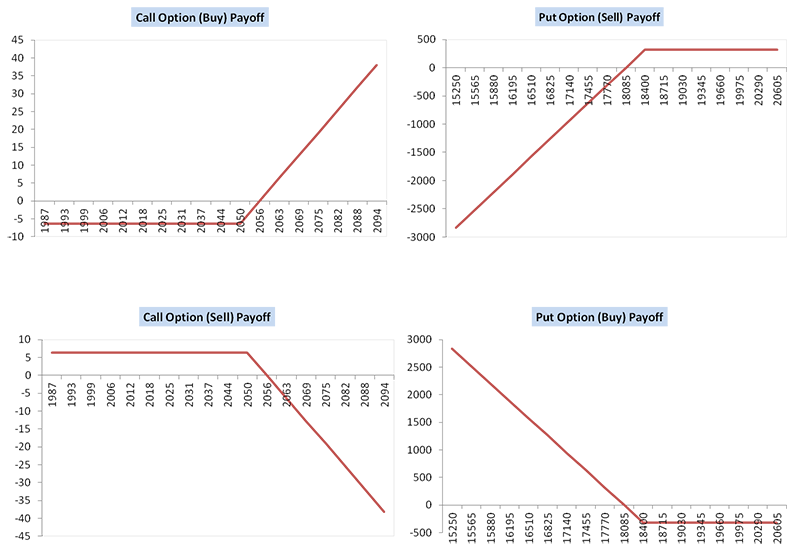
Arranging the Payoff diagrams in the to a higher place fashion helps united states of america understand a few things better. Permit me list them for y'all –
- Let u.s.a. start from the left side – if y'all discover we have stacked the pay off diagram of Telephone call Option (buy) and Call option (sell) i below the other. If yous look at the payoff diagram carefully, they both look like a mirror image. The mirror epitome of the payoff emphasis the fact that the risk-advantage characteristics of an selection heir-apparent and seller are opposite. The maximum loss of the call option heir-apparent is the maximum profit of the phone call pick seller. Likewise, the call pick buyer has unlimited profit potential, mirroring this the call option seller has maximum loss potential.
- We have placed the payoff of Call Option (buy) and Put Option (sell) next to each other. This is to emphasize that both these option variants brand money only when the market is expected to go higher. In other words, do non buy a phone call option or do non sell a put selection when you sense there is a adventure for the markets to get down. You will not make coin doing so, or in other words, you lot will certainly lose money in such circumstances. Of course, there is an angle of volatility here which we have not discussed yet; we will discuss the same going forward. The reason why I'm talking about volatility is that volatility has an impact on pick premiums.
- Finally, on the correct, the pay off diagram of Put Selection (sell) and the Put Option (buy) are stacked one beneath the other. Clearly, the pay off diagrams looks like the mirror image of one another. The mirror image of the payoff emphasizes the fact that the maximum loss of the put option heir-apparent is the maximum profit of the put pick seller. Besides, the put option buyer has unlimited profit potential, mirroring this the put option seller has maximum loss potential.
Further, here is a table where the option positions are summarized.
| Your Market View | Option Type | Position also chosen | Other Alternatives | Premium |
|---|---|---|---|---|
| Bullish | Call Option (Buy) | Long Phone call | Buy Futures or Buy Spot | Pay |
| Apartment or Bullish | Put Option (Sell) | Short Put | Buy Futures or Buy Spot | Receive |
| Flat or Bearish | Telephone call Option (Sell) | Short Phone call | Sell Futures | Receive |
| Bearish | Put Option (Buy) | Long Put | Sell Futures | Pay |
It would assist if you remembered that when yous buy an option, it is besides called a 'Long' position. Going by that, buying a call option and buying a put selection is called Long Telephone call and Long Put position respectively.
Likewise, whenever you sell an option, it is called a 'Short' position. Going by that, selling a call option and selling a put choice is also called Brusque Call and Curt Put position respectively.
At present here is some other important thing to note, y'all can buy an pick nether 2 circumstances –
- You buy to create a fresh choice position.
- You buy intending to close an existing curt position.
The position is called 'Long Option' only if you are creating a fresh buy position. If yous are ownership with and intention of closing an existing short position, and then it is but called a 'square off' position.
Similarly, y'all can sell an option nether 2 circumstances –
- Yous sell intending to create a fresh short position.
- Y'all sell intending to close an existing long position.
The position is called 'Short Choice' merely if yous are creating a fresh sell (writing an option) position. If you are selling with and intention of closing an existing long position, then it is merely called a 'foursquare off' position.
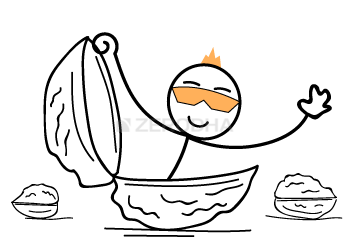
7.2 – Option Heir-apparent in a nutshell
By at present, I'm certain you would have a basic understanding of the telephone call and put option both from the buyer'due south and seller'south perspective. However, I recollect information technology is best to reiterate a few primal points earlier we make farther progress in this module.
Ownership an choice (call or put) makes sense only when we expect the marketplace to motion strongly in a certain direction. If fact, for the option buyer to be assisting, the market should move abroad from the selected strike cost. Selecting the correct strike price to merchandise is a major task; we will acquire this at a later stage. For now, here are a few cardinal points that you should remember –
- P&L (Long phone call) upon decease is calculated equally P&Fifty = Max [0, (Spot Price – Strike Price)] – Premium Paid
- P&50 (Long Put) upon expiry is calculated as P&L = [Max (0, Strike Price – Spot Toll)] – Premium Paid
- The in a higher place formula is applicable merely when the trader intends to hold the long pick till death
- The intrinsic value calculation we have looked at in the previous chapters is but applicable on the expiry twenty-four hours. We CANNOT use the same formula during the series
- The P&L adding changes when the trader intends to square off the position well before the death
- The buyer of an option has limited run a risk, to the extent of the premium paid. Withal, he enjoys an unlimited turn a profit potential
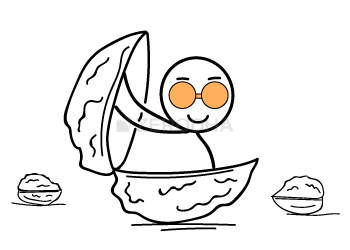
7.2 – Option seller in a nutshell
The selection sellers (telephone call or put) are also called the option writers. The buyers and sellers have the exact contrary P&L experience. Selling an pick makes sense when you lot look the marketplace to remain flat or below the strike price (in case of calls) or above strike cost (in case of put pick).
I desire you to appreciate the fact that all else equal, markets are slightly favourable to option sellers. This is because, for the option sellers to be profitable the marketplace has to be either flat or movement in a certain direction (based on the type of pick). However for the option buyer to be assisting, the market place has to movement in a certain direction. Conspicuously there are two favorable market conditions for the selection seller versus one favorable condition for the option buyer. But of grade, this in itself should non be a reason to sell options.
Here are a few key points yous need to call back when it comes to selling options –
- P&L for a brusque telephone call option upon expiry is calculated as P&50 = Premium Received – Max [0, (Spot Cost – Strike Price)]
- P&L for a short put option upon expiry is calculated as P&L = Premium Received – Max (0, Strike Price – Spot Price)
- Of class the P&50 formula is applicative only if the trader intends to hold the position till expiry
- When y'all write options, margins are blocked in your trading business relationship
- The seller of the choice has unlimited risk but minimal turn a profit potential (to the extent of the premium received)
Perhaps this is the reason why Nassim Nicholas Taleb in his book "Fooled by Randomness" says "Option writers eat like a chicken but shit like an elephant". This ways to say that the option writers earn minor and steady returns past selling options, merely when a disaster happens, they tend to lose a fortune.
Well, with this I promise you have developed a strong foundation on how a Call and Put option behaves. To give you a heads up, the focus going forward in this module will be on moneyness of an pick, premiums, selection pricing, option Greeks, and strike choice. Once we sympathize these topics, we will revisit the call and put option all over again. When we do then, I'm certain you volition run into the calls and puts in a new light and perhaps develop a vision to trade options professionally.
vii.3 – A quick annotation on Premiums
Accept a look at the snapshot below –
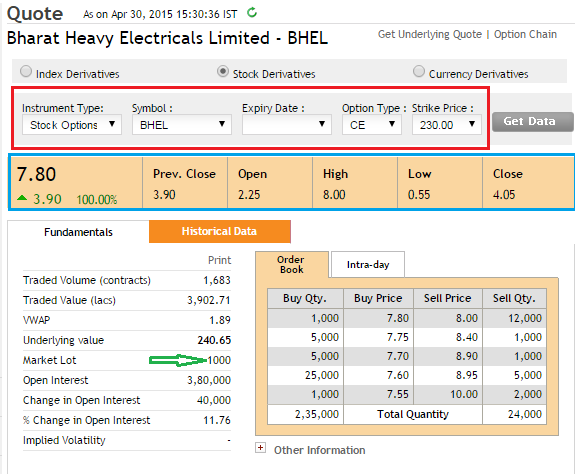
This is the snapshot of how the premium has behaved on an intraday basis (30th April 2015) for BHEL. The strike nether consideration is 230, and the option type is a European Telephone call Option (CE). This information is highlighted in the red box. Below the red box, I take highlighted the price information of the premium. If yous notice, the premium of the 230 CE opened at Rs.ii.25, shot up to make a high of Rs.8/- and closed the day at Rs.4.05/-.
Think nigh it; the premium has gyrated over 350% intraday! i.e. from Rs.ii.25/- to Rs.8/-, and it roughly closed up 180% for the mean solar day, i.east. from Rs.two.25/- to Rs.four.05/-. Moves similar this should not surprise you. These are adequately common to wait in the options world.
Presume in this massive swing y'all managed to capture just 2 points while trading this item option intraday. This translates to a sugariness Rs.2000/- in profits considering the lot size is 1000 (highlighted in light-green arrow). In fact this is exactly what happens in the real world. Traders trade premiums. Inappreciably any traders hold option contracts until expiry. Well-nigh of the traders are interested in initiating a trade now and squaring it off in a short while (intraday or maybe for a few days) and capturing the movements in the premium. They exercise not actually wait for the options to expire.
In fact, y'all might exist interested to know that a return of 100% or so while trading options is not actually a thing of surprise. Only delight don't only go carried away with what I just said; to savor such returns consistently you demand to develop a deep insight into options.
Take a look at this snapshot –
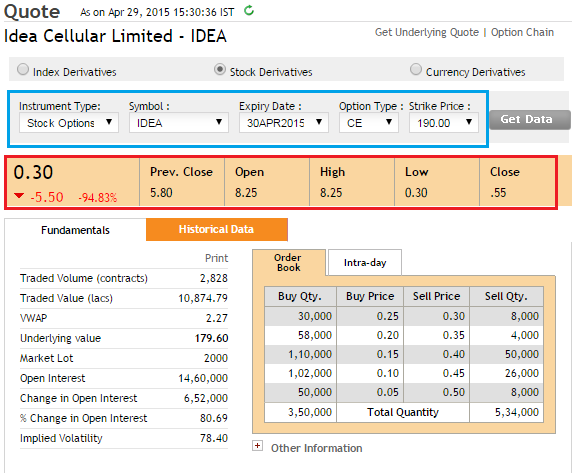
This is the option contract of Thought Cellular Limited, strike price is 190, expiry is on xxxth April 2015 and the option type is a European Call Option . These details are marked in the blue box. Beneath this we can find the OHLC data, which quite obviously is very interesting.
The 190CE premium opened the 24-hour interval at Rs.8.25/- and made a low of Rs.0.30/-. I volition skip the % calculation simply considering it is a ridiculous figure for intraday. However presume you were a seller of the 190 call pick intraday and you managed to capture merely 2 points again, considering the lot size is 2000, the two point capture on the premium translates to Rs.4000/- in profits intraday, skilful enough for that nice dinner at Marriot with your better half J.
The indicate that I'm trying to make is that, traders (most of them) merchandise options only to capture the variations in premium. They don't really bother to agree till expiry. However by no means I am suggesting that you demand not hold until expiry, in fact I do concur options till decease in certain cases. Generally, speaking option sellers tend to hold contracts till expiry rather than selection buyers. This is because if y'all have written an option for Rs.viii/- you lot will savour the full premium received, i.due east. Rs.8/- merely on expiry.
So having said that the traders prefer to trade just the premiums, you may have a few fundamental questions cropping up in your heed. Why practise premiums vary? What is the basis for the change in premium? How can I predict the change in premiums? Who decides what should be the premium cost of a particular option?
Well, these questions and therefore, the answers to these course the crux of pick trading. If you can chief these aspects of an option, let me clinch you that y'all would fix yourself on a professional path to merchandise options.
To requite you a heads up – the answers to all these questions lies in understanding the 4 forces that simultaneously exerts its influence on options premiums, as a result of which the premiums vary. Remember of this equally a ship sailing in the sea. The speed at which the ship sails (assume its equivalent to the option premium) depends on various forces such every bit current of air speed, sea water density, sea pressure, and the power of the ship. Some forces tend to increase the speed of the ship, while some tend to decrease the speed of the ship. The ship battles these forces and finally arrives at an optimal sailing speed.
Besides the premium of the option depends on certain forces called as the 'Option Greeks'. Crudely put, some Option Greeks tends to increase the premium, while some endeavor to reduce the premium. A formula chosen the 'Blackness & Scholes Option Pricing Formula' employs these forces and translates the forces into a number, which is the premium of the option.
Endeavor and imagine this – the Pick Greeks influence the option premium; notwithstanding, the Pick Greeks itself are controlled by the markets. As the markets change on a minute past minute ground, therefore the Choice Greeks change and therefore the option premiums!
In the future, in this module, nosotros volition understand each of these forces and their characteristics. Nosotros will understand how the forcefulness gets influenced by the markets and how the Option Greeks farther influence the premium.
And so the end objective here would exist to exist –
- To get a sense of how the Option Greeks influence premiums
- To effigy out how the premiums are priced considering Option Greeks and their influence
- Finally keeping the Greeks and pricing in perspective, we demand to smartly select strike prices to trade
I of the key things nosotros need to know before we attempt to learn the choice Greeks is to learn about the 'Moneyness of an Option'. We will do the same in the next affiliate.
A quick note here – the topics in the future will get a little complex, although nosotros will effort our best to simplify it. While we do that, we would request you to please be thorough with all the concepts we have learnt then far.
Key takeaways from this chapter
- Buy a call option or sell a put choice only when y'all expect the market to go up
- Buy a put option or sell a call choice but when y'all wait the market to go down
- The buyer of an selection has unlimited turn a profit potential and limited risk (to the extent of the premium paid)
- The seller of an selection has an unlimited risk potential and limited reward (to the extent of the premium received)
- Majority of options traders prefer to trade options just to capture the variation in premiums
- Choice premiums tend to gyrate drastically – equally an options trader, and y'all tin can wait this to happen quite oft.
- Premiums vary as a function of iv forces chosen the Pick Greeks
- Black & Sholes option pricing formula employs four forces as inputs to give out a toll for the premium
- Markets control the Option Greeks and the Greek'south variation itself
Source: https://zerodha.com/varsity/chapter/summarizing-call-put-options/
0 Response to "If You Sell a Put Option if You Sell Shares of a Stock Can You Buy It Again"
Post a Comment